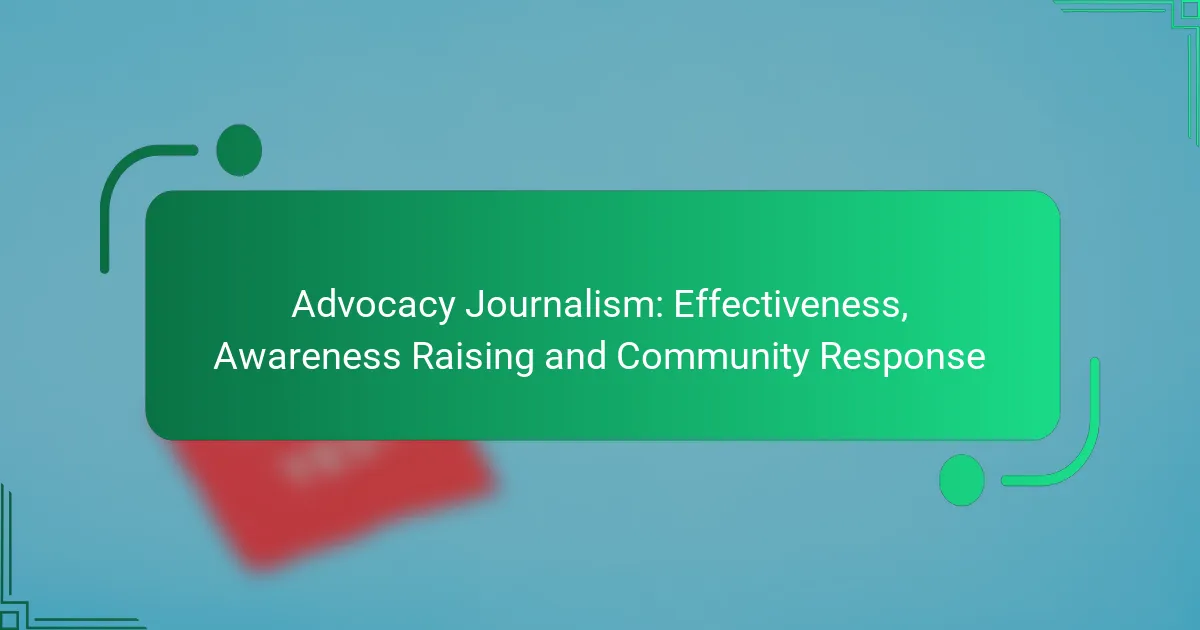Advocacy journalism plays a crucial role in raising awareness about pressing social issues by informing the public and shaping opinions. By combining investigative reporting with a commitment to social change, it fosters community engagement and action, ensuring that marginalized voices are heard and local concerns are addressed effectively.

How effective is advocacy journalism in raising awareness?
Advocacy journalism is highly effective in raising awareness about social issues by informing the public and influencing opinions. It combines investigative reporting with a commitment to social change, often leading to increased engagement and action from communities.
Impact on public opinion
Advocacy journalism significantly shapes public opinion by highlighting underreported issues and presenting them in a compelling manner. By focusing on personal stories and factual evidence, it can sway perceptions and motivate individuals to take action.
For instance, coverage of environmental issues can lead to heightened awareness about climate change, prompting community discussions and policy changes. The emotional resonance of advocacy journalism often makes complex topics more relatable and urgent.
Case studies of successful campaigns
Numerous advocacy journalism campaigns have successfully raised awareness and prompted change. One notable example is the coverage of the Flint water crisis, which brought national attention to the dangers of lead contamination and spurred governmental action.
Another example is the reporting on the #MeToo movement, which not only raised awareness about sexual harassment but also led to significant cultural shifts and policy reforms in workplaces across various sectors.
Role in social movements
Advocacy journalism plays a critical role in social movements by amplifying voices that are often marginalized. It provides a platform for activists to share their messages and mobilize support, effectively bridging the gap between grassroots efforts and broader public engagement.
Through detailed reporting and storytelling, advocacy journalism can inspire solidarity and action, as seen in movements like Black Lives Matter, where media coverage helped to galvanize widespread protests and discussions on racial justice.

What strategies enhance the effectiveness of advocacy journalism?
Effective advocacy journalism employs various strategies to raise awareness and drive community response. Key approaches include leveraging social media, collaborating with NGOs, and actively engaging local communities to amplify messages and foster action.
Utilizing social media platforms
Social media platforms are powerful tools for advocacy journalism, allowing journalists to reach broad audiences quickly. By sharing compelling stories, visuals, and calls to action, journalists can engage users and encourage them to participate in advocacy efforts.
To enhance effectiveness, journalists should tailor content for each platform, using hashtags and trends to increase visibility. Regular interaction with followers can also build a loyal community that shares and supports advocacy messages.
Collaborations with NGOs
Partnering with non-governmental organizations (NGOs) can significantly boost the impact of advocacy journalism. NGOs often have established networks and resources that can help amplify journalistic efforts, providing access to expert insights and grassroots connections.
When collaborating, it’s essential to align on goals and messaging to ensure consistency. Joint campaigns or events can leverage both the journalistic platform and the NGO’s reach, creating a more substantial impact on the target audience.
Engaging local communities
Engaging local communities is crucial for advocacy journalism to resonate and drive action. Journalists should prioritize understanding community issues, values, and concerns, which can inform more relevant and impactful storytelling.
Methods for engagement include hosting community forums, conducting interviews, and facilitating discussions that allow community members to voice their perspectives. This approach not only enriches the content but also fosters a sense of ownership among community members, encouraging them to advocate for change.

How does advocacy journalism respond to community needs?
Advocacy journalism addresses community needs by highlighting local issues, amplifying marginalized voices, and fostering dialogue among residents. This approach ensures that the concerns of the community are not only reported but actively engaged with, leading to informed responses and potential solutions.
Identifying local issues
Advocacy journalism plays a crucial role in uncovering and spotlighting local issues that may otherwise go unnoticed. Journalists often engage with community members to understand their challenges, whether related to housing, healthcare, or education. This grassroots approach helps ensure that the most pressing concerns are prioritized in public discourse.
For example, a local news outlet might investigate rising housing costs in a neighborhood, providing data and personal stories that illustrate the impact on residents. By framing these issues in a relatable manner, advocacy journalism can mobilize community action and attract attention from policymakers.
Providing a platform for marginalized voices
One of the primary functions of advocacy journalism is to give a voice to marginalized groups who may lack representation in mainstream media. This includes individuals from low-income backgrounds, racial minorities, and other underrepresented communities. By sharing their stories, advocacy journalism helps to humanize these issues and foster empathy among a broader audience.
For instance, a series of articles might focus on the experiences of refugees in a city, highlighting their struggles and contributions. This not only raises awareness but also encourages community support and policy changes that benefit these groups.
Facilitating community dialogue
Advocacy journalism encourages open dialogue within the community by providing a forum for discussion and debate. This can take the form of public forums, online discussions, or collaborative projects with local organizations. By facilitating these conversations, journalists help to bridge gaps between different community members and stakeholders.
For example, a local newspaper might host a town hall meeting to discuss a controversial development project, allowing residents to voice their opinions and concerns. This engagement can lead to more informed decision-making and a sense of ownership among community members regarding local issues.

What are the challenges faced by advocacy journalists?
Advocacy journalists encounter several significant challenges that can hinder their effectiveness. These include limited funding, the need to balance objectivity with advocacy, and navigating legal and ethical concerns.
Funding and resource limitations
Funding is a critical challenge for advocacy journalists, as many operate on tight budgets or rely on grants and donations. This can restrict their ability to conduct in-depth investigations or cover important issues comprehensively.
Resource limitations often lead to a lack of staff and technological support, making it difficult to produce high-quality content consistently. Journalists may need to prioritize stories based on available resources, which can result in important issues being overlooked.
Balancing objectivity and advocacy
Advocacy journalists must navigate the fine line between promoting a cause and maintaining journalistic integrity. Striking this balance is essential to ensure credibility while still advocating for social change.
To maintain objectivity, journalists should present multiple viewpoints and back their claims with solid evidence. This approach not only enhances credibility but also fosters trust among audiences who may be skeptical of biased reporting.
Legal and ethical concerns
Legal issues, such as defamation and copyright infringement, pose significant risks for advocacy journalists. They must be well-versed in media laws to avoid potential lawsuits that could arise from their reporting.
Ethical concerns also play a crucial role, as journalists must consider the impact of their work on the communities they represent. Adhering to ethical guidelines, such as transparency and fairness, is vital to maintaining public trust and ensuring responsible journalism.

How can advocacy journalism be measured for impact?
Advocacy journalism can be measured for impact through various qualitative and quantitative metrics that assess its effectiveness in raising awareness and prompting community responses. These measurements help determine how well the journalism influences public opinion, policy changes, and community engagement.
Metrics for success
Metrics for success in advocacy journalism include audience reach, engagement levels, and changes in public perception. For instance, tracking website traffic, social media shares, and comments can provide insight into how many people are engaging with the content. Additionally, measuring shifts in public opinion through polls before and after the publication can indicate the journalism’s influence.
Another important metric is the number of actionable outcomes resulting from the journalism, such as policy changes or community initiatives that arise in response to the issues highlighted. Keeping a record of these outcomes can help quantify the impact of advocacy efforts.
Surveys and feedback mechanisms
Surveys and feedback mechanisms are essential tools for gauging the effectiveness of advocacy journalism. Conducting surveys among the target audience can reveal their awareness of the issues covered and their attitudes towards them. This feedback can be collected through online forms, social media polls, or community forums.
Incorporating direct feedback from the community, such as comments or testimonials, can provide qualitative insights into how the journalism resonates with individuals. This information can guide future advocacy efforts and help refine messaging strategies.
Long-term community changes
Long-term community changes are a critical indicator of the impact of advocacy journalism. Observing shifts in community behavior, such as increased participation in local initiatives or changes in civic engagement, can demonstrate the journalism’s lasting effects. For example, if a series of articles leads to a community organizing around a specific issue, this can be seen as a direct outcome of the advocacy efforts.
Tracking these changes over time, such as through follow-up surveys or community assessments, can provide a clearer picture of the journalism’s influence. It is important to establish baseline data before the advocacy work begins to effectively measure these long-term impacts.

What role do digital platforms play in advocacy journalism?
Digital platforms are crucial in advocacy journalism as they enhance visibility and facilitate interaction between journalists and their audiences. These platforms allow for the rapid dissemination of information and enable communities to engage with issues that matter to them.
Increased reach and engagement
Digital platforms significantly expand the reach of advocacy journalism by allowing content to be shared widely across social media and other online channels. This increased visibility can lead to higher engagement rates, as audiences are more likely to interact with content that resonates with their values and concerns.
For example, a campaign focused on climate change can utilize platforms like Twitter and Facebook to mobilize support, share petitions, and encourage discussions. Engaging visuals and compelling narratives can further enhance audience interaction, leading to a more informed and active community.
Data-driven storytelling
Data-driven storytelling leverages analytics and research to create compelling narratives that resonate with audiences. By incorporating statistics and factual evidence, advocacy journalism can present a more persuasive case for social issues, making it easier for readers to understand the urgency of the cause.
For instance, using data to highlight the impact of pollution on public health can help frame the narrative in a way that emphasizes the need for policy changes. Journalists can utilize tools like infographics and interactive maps to present this data visually, making complex information more accessible and engaging for the audience.
